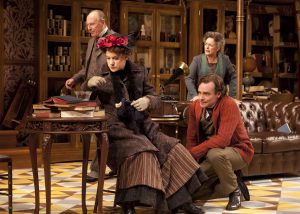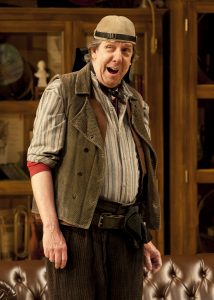No Lack of Support for Old Globe Pygmalion
The Old Globe Theatre has mounted a stately production of George Bernard Shaw’s best comedy – Pygmalion – on the occasion of the play’s centenary. (It was first performed, in German, at Vienna for reasons both complicated and uninteresting.)
Most of the Globe’s strengths are in evidence. Alexander Dodge’s set is gorgeous and witty, packed with tactile clutter and boasting a handsome parquet floor, which revolves (usually) when needed. The Robert Morgan costumes are precisely right, Philip S. Rosenberg has frosted everything with appropriate illumination and Mark Bennett has provided crisp musical punctuation with custom-made noodlings in the style of Edwardian tea dance.
When Kandis Chappell glides downstage center and shares observations of sophisticated common sense, we understand what aristocracy is. When juicy old Don Sparks takes center stage to deplore how middle-class morality has ruined him by making him prosperous, we grasp the concept of wry irony. And Paxton Whitehead has merely to clear his rich baritone throat to signal that all’s well in the British Empire.

Paxton Whitehead, Charlotte Parry, Robert Sean Leonard, Deborah Taylor in Old Globe Pygmalion. Henry DiRocco Photo
But this play is written not for its luxe textures but instead as a setting for its central theme of transformation. Henry Higgins, the master of phonetics, makes a bet that he can pass off the coarse flower girl Liza Doolittle as a duchess, just by teaching her to speak properly. And in six months or less.
Critic Eric Bentley, usually thought of as a premiere scholar of Brecht, made some splendid points about Pygmalion. It is, suggests Bentley, actually two plays, the one in which Higgins turns Eliza from flower-girl to duchess and the one in which the duchess becomes a woman. Because Higgins triumphs by the end of the third act, leaving two more acts in which to answer the key question: What happens now to the transformed flower girl?
This is Shaw struggling with his ego and his libido. Higgins is his surrogate; Eliza represents – what? – his audience? Posterity? The education of the race?
There is no way Shaw will let Higgins lose. But he adores Eliza. (He had a tempestuous and carnal relationship with the actress Mrs. Patrick Campbell who, though far too old for the role, he insisted play it under his direction for the London production.) And he wants her to win through and become worthy of his attention, not as a conquest but as a “consort battleship.”
So everything depends upon the actress playing Eliza. The Globe production disappoints.
Charlotte Parry seems a confident, well-trained actress with plenty of tools. But here, she’s more a proper item of décor than a featured center of attention. She starts stiff and remains so. She doesn’t make a very long journey in a role about transformation. Her attempts to match the supporting cast in declarative vigor ring flat. She is not a force of nature, just a random flower girl.
Robert Sean Leonard is somewhat more effective as Higgins, prowling and preening. Too often, though his impatience staggers toward exasperation and he seems about to lose control, a very non-Higgins trait.
For the rest of his life, Shaw fought against the overwhelming desire of the public to pair up Higgins and Eliza at the final curtain. He even wrote one of his epilog essays detailing how she married one of her lightweight upper-class suitors and figured out how to support him. But the world usually won either through subtle suggestion – the original Higgins tossed a flower to Mrs. Pat on her final exit – or subterfuge: For the 1938 film version a “happy ending” was filmed by Wendy Heller and Leslie Howard without Shaw’s knowledge and slipped into the release print. He won the screenplay Oscar that year anyhow.
At the Globe, director Nicholas Martin is faithful to his author at the end, even overly so. But even he allows just a touch of ambiguity. Otherwise, this is a terrific staging, deeply enriched by the supporting cast, the décor, Jan Gist’s extra-important dialect coaching and a general respect for one of the 20th Century’s towering artistic intellects.
And Martin deserves special credit for ignoring the two-ton gorilla in the room: My Fair Lady. Shaw refused to consider an operetta based on his play, preferring the play’s “own verbal music.” But his estate decided otherwise and the world is richer for an additional masterpiece. Alan Jay Lerner and Frederick Loewe took all of Shaw’s best lines and most of his story points to make My Fair Lady into an entertainment more emotional than intellectual. Sadly, the musical has tended to dim the play’s resonance. Work such as Martin’s, which basically just ignores the musical, restores a choice.
The musical hasn’t time for the richness Martin gets from Miss Chappell and, as Higgins’ house keeper, Deborah Taylor as the matriarchs of empire and the contrasting indomitability of Whitehead and Sparks as the two ends of the empire’s spine.

Don Sparks in Old Globe Pygmalion. Henry DiRocco Photo
It’s impossible to over-value the care with which this production has been put together, even to the tiniest roles. It celebrates a world defined by Gilbert and Sullivan, later mined so effectively by P. G. Wodehouse and ultimately crashed by Monty Python.
As we can see at the Globe, Shaw ruled the peak of that curve.
[box] Continues at 8 p.m. Thursdays-Saturdays; 7 p.m. Tuesdays, Wednesdays and Sundays; and 2 p.m. Saturdays and Sundays through Feb. 24, 2013.[/box]
[

Welton Jones has been following entertainment and the arts around for years, writing about them. Thirty-five of those years were spent at the UNION-TRIBUNE, the last decade was with SANDIEGO.COM.


